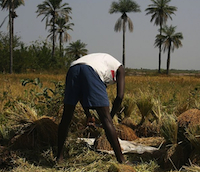Friday, April 26, 2024
News and Views from the Global South
SENEGAL: Small-Scale Irrigation: Key to Rural Development
- Over the past four years, the Local Small-scale Irritation Project has spent more than $10.5 million U.S. dollars supporting rural communities in Senegal.

Harvesting rice in Senegal: irrigation projects have greatly improved yields and incomes. Credit: Olivier Epron/Wikicommons
These water reserves have contributed to increased rice yields, which grew from less than one tonne per hectare in 2003 to three to six tonnes per hectare in 2009. It also allowed the development of off-season horticulture, rice cultivation and vegetable gardening. Communities in target villages of Fatick, Tambacounda and Kolda Kédougou also achieved six to eight months self-sufficiency in rice crops.
“The project has also helped increase the income of more than 6,000 farmers by over 50 percent; replenished the water table; launched micro-projects (in water supply and sanitation), and an anti-salinisation campaign,” Wally Gueye, technical advisor to the Ministry of Environment told IPS.
He said more than 2,100 hectares of land that had been rendered saline was reclaimed; preventive measures were taken to protect a further 9,800 hectares of land at risk. of salinity.
“The activities conducted in different regions often exceeded targets,” said PAPIL coordinator Amadou Baba Sy, “whether it be seedling production and reforestation, creating and maintaining fire-breaks, or cattle rangeland clearing and maintenance.”
He added that a programme on water-borne diseases was implemented by regional medical centres which included information, public education and communication campaigns along with advocacy tools.
Sy emphasized that the persistent food and financial crisis, the adverse effects of climate change, floods caused by torrential rains, desert encroachment, coastal erosion and loss of ecosystems have combined to hinder some of PAPIL’s achievements.
He also said there were still some difficulties to be overcome before the programme can expand nationally. These difficulties are mainly tied to implementation delays and funding gaps.
An agreement was signed in February between the United States Agency for International Development (USAID) and PAPIL defining a framework for collaboration, co-managing and co-financing joint activities and guaranteeing the project’s sustainability as a tool for grassroots development, Sy told IPS.
A total of 207 microprojects amounting to about $1.6 million dollars are available to rural communities, according to Sy. The projects include 35 for water education, 10 health, and 98 for post-harvest equipment.
Jeffrey Povolny, Senegal director of USAID/Wula Nafaa (“Benefits of the Forest” in Bambara), states that USAID has the added intention to work with PAPIL to help the Senegalese government improve its agricultural policies and activities.
“We work on the same issues. It was logical for us to combine our efforts and work together for better returns,” he says. The overall objective of USAID / Wula Nafaa is to contribute to poverty reduction and sustainable local development by increasing the income of rural producers and local communities, he told IPS.
Ibrahima Diouf, coordinator of a group of farmers who’ve been participating in the project in Fatick for over three years, the breadth and productivity of rice cultivation have increased considerably.
“Our group, which includes over one hundred people, has more than five hectares of rice… Currently we’re supported by PAPIL especially regarding irrigation. We also produce garden vegetables, a very profitable undertaking,” he told IPS.
Famara Sarr, vice-chairman of Fatick’s regional council, said it was important to encourage the government to provide more resources to the project.
“Lack of funding prevents PAPIL from reaching approximately 65 percent of farmed regions and 70 percent of other agricultural production areas,” he says. “The project must be institutionalised to support communities with programmes that are to everyone’s advantage.”

 Print
Print



